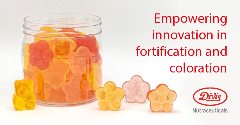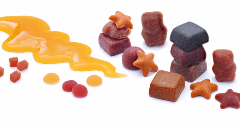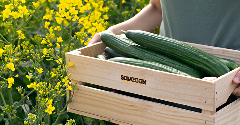News
Natural Selection
3 Nov 2014Consumers are more interested in the health properties of the products they consume than ever before. New products emphasising the quality of the natural approach are enjoying substantial popularity, and many companies are changing recipes to meet this demand. Companies are looking to strategically reduce the sugar content of products, yet consumers still want products […]

Consumers are more interested in the health properties of the products they consume than ever before. New products emphasising the quality of the natural approach are enjoying substantial popularity, and many companies are changing recipes to meet this demand.
Companies are looking to strategically reduce the sugar content of products, yet consumers still want products to taste good and look attractive, so the challenge is to find new flavourings to replace existing ingredients.
The move towards natural flavours has become increasingly apparent in recent years – and the development of natural flavours is such that they have been able to replace artificial ingredients in many products with no noticeable difference in taste and mouthfeel. This is also helping increase the options for consumers: nut-free nut products, for example, can allow those with allergies to enjoy a wider range of choice.
As the UK Flavour Association points out, customers are always willing to try something new – be it Asian, fusion, exotic fruit or reduced sugar – and so a wider range of ingredients is now becoming commonplace in food manufacturing.
UK producers, for example, are making use of freekeh, an ancient grain native to Lebanon, Syria, Jordan and Egypt. The roasted green cracked wheat could well follow in the success of quinoa, amaranth, buckwheat, kamut, millet, sorghum and teff, which have all seen a considerable rise in popularity over the last few years.
There is also something of an increasing demand for botanical flavours, with cardamom from the Himalayas, oregano from Italy or coriander from Morocco all helping to create interesting taste combinations and offer a real point of interest on the shelves.
Natural blossom flavours such as rose, violet, lavender, lotus blossom and hibiscus are now also becoming commonplace in the food and drink sector. It used to be that the cosmetics and pharmaceuticals sectors would be alone in using these flavours, but food and drink products with a hint of rose, lavender or hibiscus are all now proving increasingly popular. 2013 saw around 70 new rose flavoured soft drinks alone introduced to the global market – an increase of over 100% compared to the previous year. Hibiscus and elderflower have enjoyed similar success.
The flavouring sector has, over the past 18 months, undergone something of a change thanks to the publication of the EU’s approved list of flavourings. In fact, while this could have been considered a burden for the industry, the harmonisation of approved flavours within the EU means it has actually been welcomed by the majority of companies as it helps simplify matters.
The increased interest in natural flavours shows no signs of abating and many major manufacturers are continuing to innovate, to huge acclaim.
Related news

Oat Barista: Innovation for game-changing beverages
20 Nov 2025
Oat Barista is a clean label, sustainable, and innovative drink base specifically designed to create the perfect foam in one single ingredient.
Read more
Empowering innovation in fortification and colouration
13 Nov 2025
Divi’s Nutraceuticals offers a large portfolio of innovative, high-quality ingredients for foods, beverages, and supplements, with bespoke solutions and expert support for product success.
Read more
From fruit to functional solutions: Meet Paradise Fruits at Fi Europe in Paris
13 Nov 2025
Paradise Fruits Solutions and Paradise Fruits Health will showcase their combined expertise in delivering innovative, fruit-based solutions to the food and beverage industry at the upcoming Fi Europe trade show (2-4 December 2025, Paris).
Read more
New UPF standard hoped to offer consumers ‘coherence and clarity’
10 Nov 2025
Ingredients companies are being urged to enter “a new era of partnership and innovation” following the launch of the industry’s first non-UPF verification scheme.
Read more
Cottage cheese makes a comeback as consumers call for cleaner labels
6 Nov 2025
From ice cream to dips and ready meals, cottage cheese is experiencing a renaissance as a high-protein, clean ingredient for health-conscious consumers.
Read more
Bord Bia presents Irish dairy ingredient suppliers at Fi Europe
6 Nov 2025
Dairygold Co-operative Society, The Carbery Group, and Ornua Co-operative: Meet with sustainable producers of Irish dairy ingredients at Food ingredients Europe 2025, Hall 7.2 Stand M18.
Read more
Shorter drying time, sweeter success!
30 Oct 2025
Curious about cost-effective, sustainable and delicious candy making? Stefan Wessel reveals how Avebe’s solutions reduce drying time and energy use by up to 50%.
Read more
Could plant-based protection replace plastic packaging?
29 Oct 2025
Swedish foodtech company Saveggy has launched an additive-free plant-based protection for cucumbers, offering a waste-free packaging solution for fruit and vegetables.
Read more
Will Wicks’ Killer Bar harm the protein bar category?
23 Oct 2025
Joe Wicks’ deliberately dangerous protein bar is fuelling anti-UPF sentiment – but there are concerns that his messaging is misguided and could have unintended consequences.
Read more
Expanding boundaries in food & beverage innovation
23 Oct 2025
IMCD and FrieslandCampina Professional expand partnership to deliver Kievit® across EMEA, enabling brands to enhance quality and accelerate time-to-market for tomorrow’s food & beverage creations.
Read more